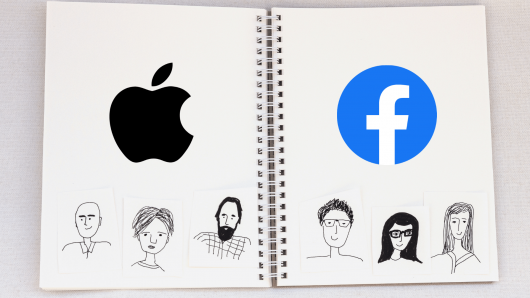The rapid evolution and growth of the digital ads ecosystems have led platforms to make changes that cater to both the consumer and business needs. Apple’s newest iOS update — to iOS 14 — is one that extensively modifies the way ads are created, tracked, and interacted with.
Facebook’s original response to the new iOS 14 policy was resistance, but it ultimately decided the best course of action was to oblige in order to provide stability for its businesses and partners.
In this post, we will go over Apple’s new iOS 14 policy, discuss the changes for both web and app advertisers, and review the required next steps to be prepared for these changes.
Apple’s New iOS 14 Policy
What Does the New iOS 14 Policy Entail?
To understand how Facebook advertising will be affected, you need to understand exactly what will be changed with the iOS 14 update. The full brief is available from Apple if you’d like to dig into the nitty-gritty details, but for those short on time, we’ve summarized the three main changes that are coming.
Data Nutrition Label
- The Data Nutrition Label will require all apps to submit how their application collects and utilizes data from its users. App owners and developers must upload this informational clause to the Apple App Store Connect.
Tracking Transparency Prompts
- All applications utilizing the Apple App store are required by the new policy to ask users for permission to track their data across third-party apps and websites. The tracking transparency prompt will appear to the user and give them the ability to accept or decline the tracking of their data, as shown below.
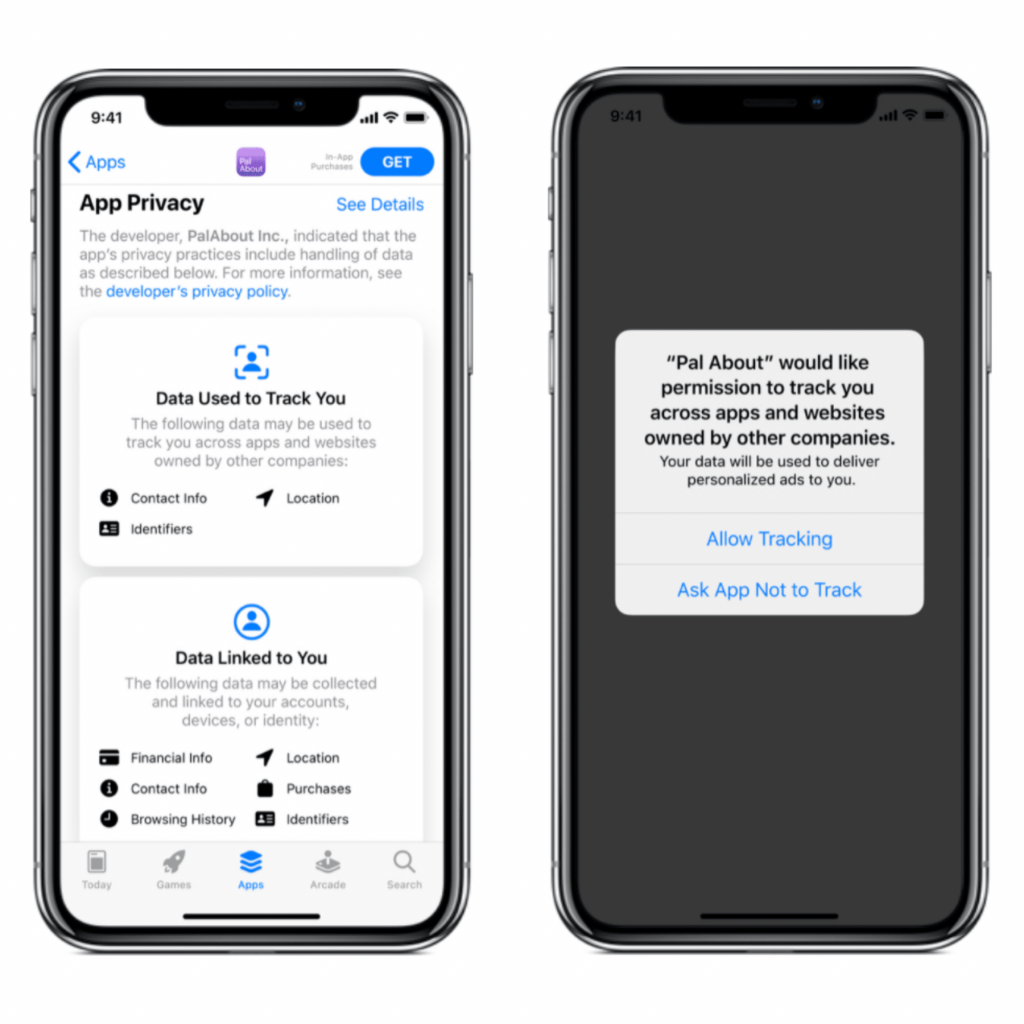
Tracking via App/Browser APIs
- Facebook and other platforms will now be required to utilize a new framework that places restrictions and could delay event reporting. The previously instantaneous reporting for App Conversion Campaigns could now be delayed up to three days with the newly adopted SKAdNetwork API (SKAN API).
What is Facebook Currently Doing to Mitigate These Changes?
While Facebook is against these changes due to the far-reaching effects they can have on small to medium-sized businesses, the technology behemoth will be adhering to the new iOS 14 policy guidelines listed above. Although these guidelines will lead to changes in the way businesses advertise, the threat of losing their relationship with Apple would ultimately be more detrimental to Facebook.
Here’s a summary of how Facebook is handling the upcoming changes:
Adhering to New Prompt Guidelines
- Previously, the Facebook platform was utilizing transparency features for ads such as the “Why am I seeing this?” button, an option to hide the ad, and an off-Facebook activity toggle switch. Users will now be prompted to decide whether they agree to allow their data to be collected or not.
Continuing to Collect Device Identifiers
- For those users who opt-in to Apple’s transparency prompt, device identifiers will be collected. Before the update, all users’ device identifiers were collected.
App-Based Business Tools
- Facebook will continue to support app-based business tools for Apple’s limited measurement solution, SKAN API, for mobile apps.
Aggregated Event Management (AEM)
- For advertisers utilizing web-based business tools, Facebook will limit the measurement of some events for iOS 14 users through the new data-sharing protocol. This new AEM system will change the way that advertisers track conversions; to learn more read Apple’s blog post.
Changes Advertisers Can Expect
The ramifications of these changes will be felt by both web and app advertisers. We’ll go over each of those changes separately, but first, let’s cover some general limitations to be aware of if you’re a Facebook or Instagram advertiser.
Ad Creation
- In terms of ad creation limitations, there are a few key changes that businesses should be aware of. For starters, Auction bidding is now the only available buying option when creating ads for devices on iOS14. Therefore, reach and frequency bidding is no longer available. For more limitations on ad creation, read Facebook’s blog post.
Reporting
- The new iOS 14 update will limit advertisers’ ability to measure the performance of campaigns on Facebook. The previous real-time reporting will no longer be supported and businesses could see a data delay of up to three days. Statistical modeling may be used to account for conversions from iOS 14 users.
- Delivery and action breakdowns including age, gender, region, and placement will not be supported.
- Attribution windows will be set at the ad set level, rather than the account level, and will be limited to a seven-day click and one-day view window.
Targeting
- The size of app connections and Custom Audiences for both app and web activity will decrease as more people opt-out of tracking on iOS 14 devices. This means that audiences may need to be broadened to capture the attention of potential customers.
Changes and Next Steps for Web Advertisers
Now, let’s go over what you can expect to change as an advertiser. If you’re an app advertiser, you can skip ahead to the next section. Web advertisers, read on
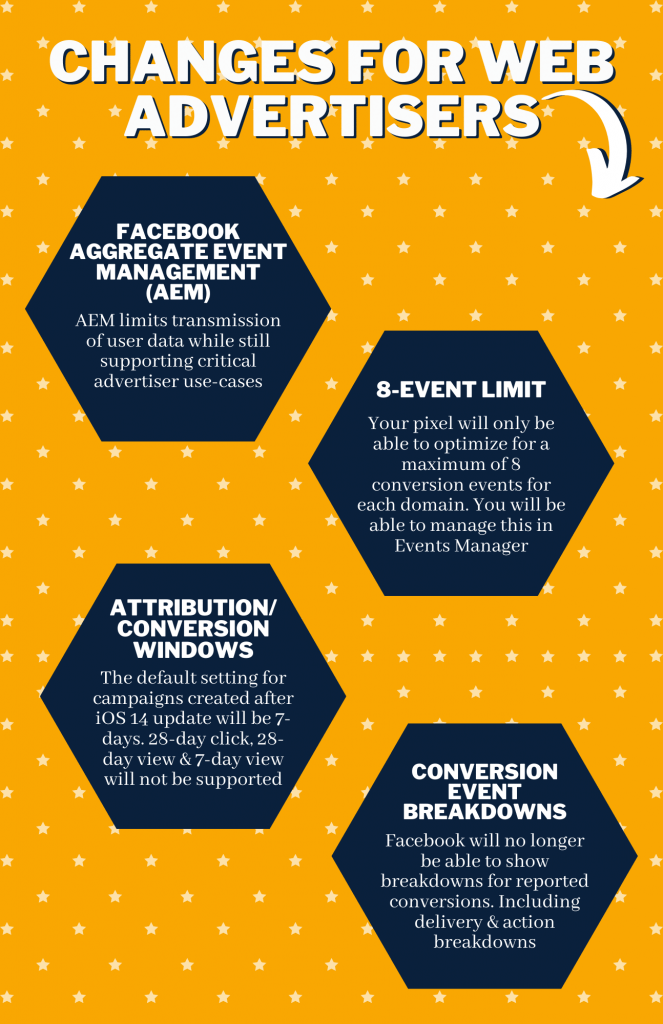
Facebook Aggregated Event Management (AEM)
Facebook will be implementing AEM to comply with Apple’s prompt. This will not solve all impacts of Apple’s protocol and advertisers will still lose functionality with these changes, but it’s their best option given the circumstances. AEM limits the transmission of user data while still supporting critical advertiser use-cases. Facebook hasn’t provided many details on AEM quite yet, but we’ll keep you posted as information continues to roll out.
8-Event Limitation
Your pixel may only track and optimize for a maximum of eight conversion events for each domain. Facebook will initially configure the conversion events they believe to be the most relevant to your business. All other events will be made inactive for campaign optimization and reporting. You will be able to manage your event priority preferences in Events Manager.
Any ad sets that are optimizing for a pixel conversion event that is no longer active due to this eight-event limitation will be paused. Those who opt-out of the data tracking will only be logged for one event completed after the ad click. This means that only customers that make it to one of your predetermined conversion events on the first ad click will be logged.
To cater to this new system, Facebook recommends setting up your eight conversion events to track the potential customer at key points of their purchase journey. For example, if a customer visits your website, adds items to their cart, but does not go through with the purchase, you will want a conversion event for both the Add to Cart event and the Purchase event. Without the Add to Cart event, the data from that customer will not be tracked unless they complete a purchase on the first ad click.
You may need to consider changes to your campaign measurement strategy. Upper-funnel event optimization (landing page views, link clicks, etc.) may be required.
Attribution and Conversion Windows
Due to limitations of the view-through signal, the default attribution setting for new campaigns after the prompt is enforced will be set to seven-day click and one-day view. Facebook will no longer be able to support 28-day click, 28-day view, and seven-day view conversion windows. In situations when there is limited data available from iOS 14 users, statistical modeling will be used for certain attribution windows. There will be in-product annotation to communicate when a metric is modeled.
Conversion Event Breakdowns
Advertisers have previously been able to break down conversion actions for more insight into consumer behavior. By accepting Apple’s prompt, Facebook will no longer be able to show breakdowns for reported conversions. This includes delivery and action breakdowns, such as age, gender, religion, and placement.
Dynamic Ads
For dynamic ads, it is important to ensure that your catalog is only utilizing one tracking pixel. The pixel will also only be able to report and optimize for a maximum of eight conversions. All other conversions will be made inactive for optimization and reporting.
Next Steps for Web Advertisers (infographic)
Now that we’ve summarized the changes, let’s go over what you can do now to prepare. In summary, you’ll need to make sure your web domain is verified in Business Manager, start preparing your list of eight priority pixel events, and prepare for the changes to attribution windows and campaign strategies.
For future preparation, campaign optimization will change as potential customers start to opt-out of data sharing. Niche-targeted campaigns could be affected by a lack of consumer data, therefore campaigns may need to be adjusted to suit broader audiences.
Overall, you will want to ensure that your campaigns are prepared for the changes coming to the Facebook advertising platform. Your agency team will help you plan for these changes and make sure your campaigns are built to any new best practices. As Facebook continues to release information, we will continue to update you on how that impacts your advertising efforts.
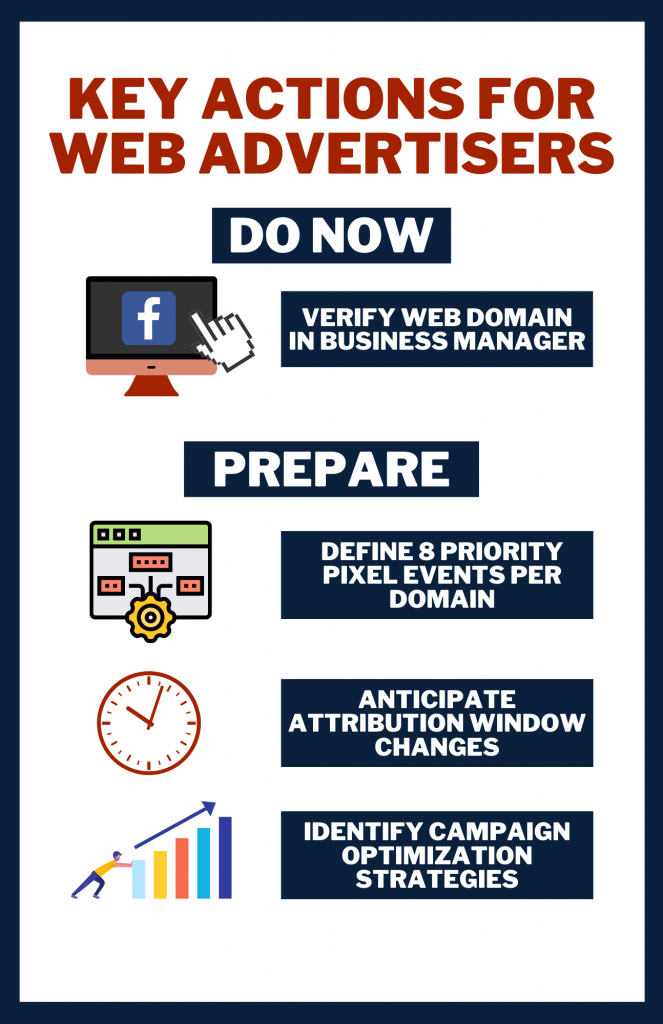
Changes and Next Steps for App Advertisers
Finally, let’s go over the changes and next steps as they relate to app advertisers.
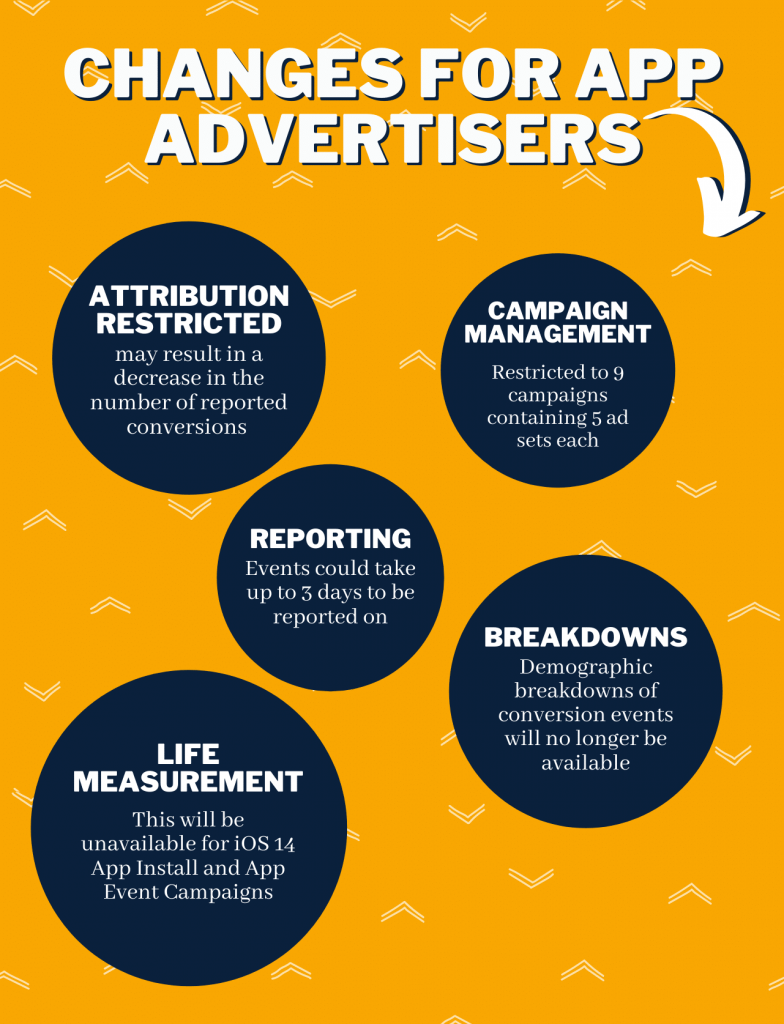
Attribution – Restricted
Conversion data shared via app business tools may be restricted, aggregated, and delayed by the SKAN API. As for attribution windows for app install campaigns, Apple’s SKAN API will be determining those windows. This change is projected to occur in mid-to-late January 2021. Facebook will initially be defaulting to a seven-day click and one-day view attribution setting. The new default attribution setting may result in a decrease in the number of reported conversions.
Campaign Management – Restricted
If you plan to run app install campaigns, you will need to ensure that your app is associated with only one ad account. An ad account may house multiple apps, however. With the new iOS 14 update, you will only be allowed to run a maximum of nine campaigns at one time. Each of these campaigns must contain no more than five ad sets per campaign and auction will be the only buying type available. Once your campaign is published, you can’t turn on or turn off the iOS 14 campaign toggle. You’ll have to turn off or delete your campaign.
Breakdowns – Aggregated
Demographic breakdowns of conversion events will no longer be available.
Lift Measurement – Aggregated
This will be unavailable for iOS14 App Install and App Event campaigns.
Reporting – Delayed
Real-time reporting will not be supported and data may be delayed up to three days. For iOS 14 app install campaigns, conversion events will be reported based on the time they are reported to Facebook by the SKAN API. Results will be aggregated at the campaign level and statistical modeling may be used to account for results at the ad set and ad levels.
Next Steps For App Advertisers (infographic)
Now that we’ve summarized the changes, let’s go over what you can do now to prepare. In summary, you’ll need to make sure to review Apple’s new privacy details and if you’re using Facebook SDK, make sure you update to version 8.1 or up. Looking ahead, you’ll also want to prepare to use an “advertiser tracking enabled” flag, configure your conversions schema for app events, plan to integrate with SKAN API, and plan to consolidate your app campaigns to one ad per account.
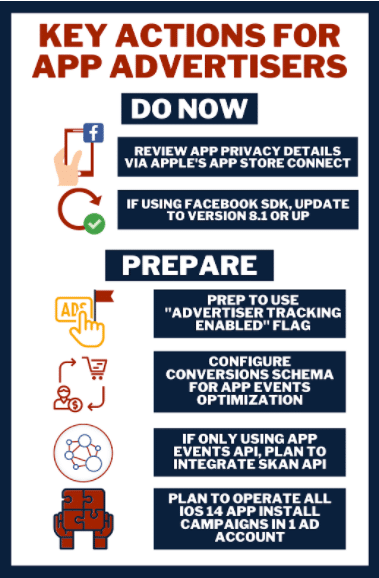
Moving Forward
The Apple iOS 14 update undoubtedly brings considerable change for all Facebook advertisers. Whether you are a web or app advertiser, this update is one that will not go unnoticed. Use the best practices set forth in this post to ensure your Facebook and Instagram ads can survive the iOS 14 update from Apple.
This post was co-authored with significant contributions from Lex Olson, Marisa Giacalone, and Erin Patten.

